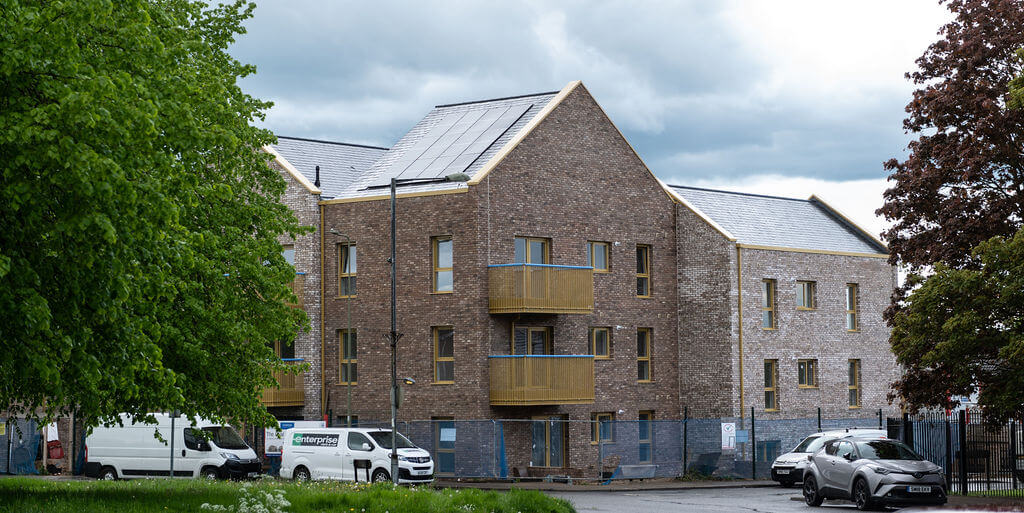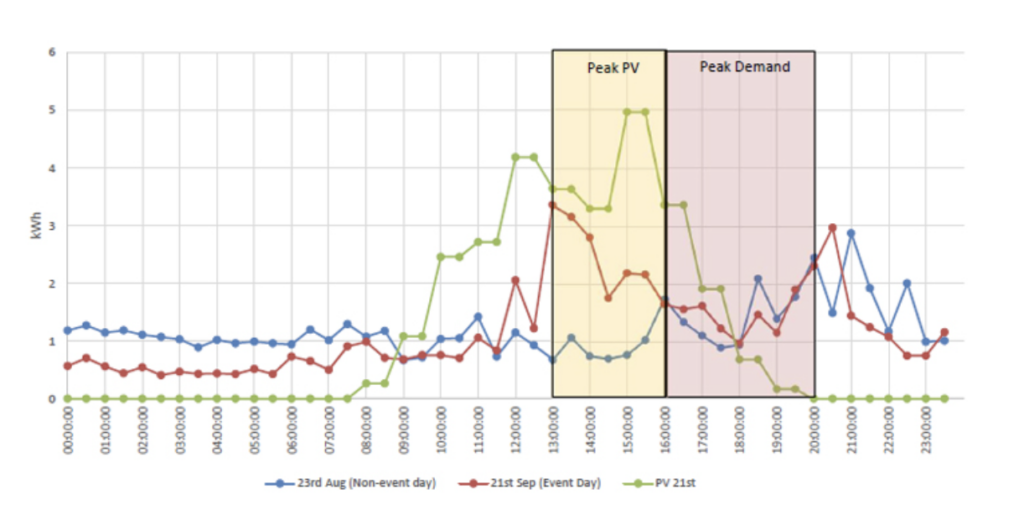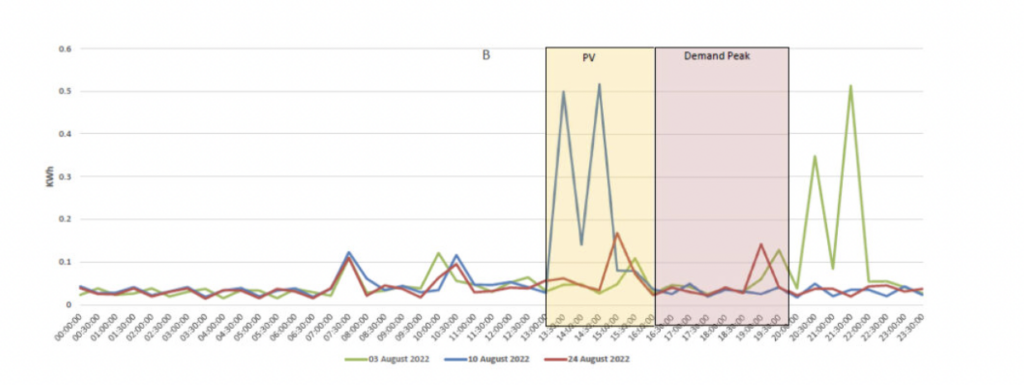Rose Hill Smart Fair Neighbourhood Project
The Rose Hill Trials formed part of Project LEO’s Smart Fair Neighbourhood (SFN) projects. These were six sets of local trials that explored how Smart Community Energy Scheme (SCES) business models can sit at the heart of a smart, low-carbon, locally balanced energy system, creating opportunities and benefits in an equitable and fair way for everyone.
While the SFN trials made up only part of Project LEO, they were a vital way for us to demonstrate how flexibility services can sit at the heart of a smarter, low-carbon, locally balanced energy system. Read the full Rose Hill case study in this companion piece report.
What were we testing at Rose Hill?
The Rose Hill SFN was comprised of 3 main areas:
The Rose Hill Solar Saver Trial looked at how tenants in blocks of flats with communal solar panels installed could benefit from flexibility services, by increasing their energy demand during peak solar hours, and learning how managing this shift could collectively make a larger impact on the building’s overall energy consumption.
The online Local Area Energy Mapping tool (LEMAP) was developed by Oxford Brookes University through EnergyRev looking at ways of developing a roadmap towards becoming a zero-carbon community, including households with the least flexibility potential.
Testing how Larger Energy Assets (solar arrays, battery storage etc.) can be used to provide flexibility, including balancing generation and demand, for example by storing it and releasing energy at different times of the day when it’s needed.
Here we will briefly look at what each element was aiming to test and what we have learned from the trials.
Understanding the Rose Hill Solar Saver Trial
The Solar Saver Trial (which concluded in February 2023) involved residents of new-build flats in Rose Hill, that had been built to a high ecological specification, having large sets of solar panels on their roofs.
The aim of the trial was to understand how people living in flats can still benefit from solar panels, even if they do not own them and don’t own the electricity they generate (the panels are owned by Low Carbon Hub and Oxford City Council) combined with testing the use of smart energy pricing offers that reward electricity use at different times.
19 flats signed up to take part in the trial and were incentivised by one-off payments, broadband access and a discount on some of their energy usage during the trial.

What did we ask participants to do?
Participating residents were asked to use Octopus as their energy supplier to participate, and to grant Project LEO permission to access their smart meter data, which is collected by Octopus on a half-hourly basis. 13 ‘event days’ were scheduled for the trials in August and September 2022. On these days, participants were asked to use more energy between 1 pm and 4 pm (during the time of peak generation from the solar panels).
It was intended that residents would move some of their more energy-hungry activities (e.g. using washing machines and dishwashers) away from Peak Demand times in the evening, to do these activities during Peak PV in the afternoon, making the most of the energy being generated by the communal solar panels. Residents kept a diary of each event day, enabling us to gain some insight into what they got up to, what they were able to change, what they found easy, and what got in the way of their shifting energy use.
Participants were rewarded with a one-off £50 credit on their energy bill and the offer of 6 months of free broadband, as well as 10p off every kWh used during the Peak PV slot on event days, and £1 per diary day submitted.
Who was involved?
The Rose Hill Solar Saver trial was run by Low Carbon Hub in partnership with Oxford City Council, OX Place, Younity, members of the community from Rose Hill and Iffley Low Carbon, working closely with Baringa, who have helped us to analyse and interpret our trial data and understand the results.
What did we learn from the Solar Saver trial?
As we hoped, the trial provided us with a rich set of data. Although the sample size is small, it does suggest that the flexibility we were looking for participants to demonstrate is possible – i.e. residents could shift their energy use in a way that makes better use of the electricity generated onsite by the rooftop solar panels.

The graph (from Baringa) summarises some of the key learnings from the trials quite neatly, showing two key results;
- Participants made better use of the energy generated by the panels on the event day (i.e. they use more when the panels are generating).
- There is still more energy being generated that could be used at that time; the space above the red line and below the green is all electricity which is being generated but not being consumed onsite and is instead being exported to the grid.
In terms of activities which enabled a shift, the most effective were using the dishwasher, washing machine and electric cooker during Peak PV.
In addition to getting a picture of average energy usage in the participating flats, we also looked at energy use on a flat-by-flat basis and compared the smart meter data to the activity diaries sent in by participants. This provided insight into the impact on energy use of specific activities (e.g. using the washing machine), and how easy residents found it to participate.
The graph below demonstrates this, showing the energy use of one flat during the trial. The 3rd of August is a non-event day, and both the 10th and 24th are event days. On the 10th, you can see a perfect shift from using electricity in the evening to using it during the Peak PV period, as requested. The participant found it harder to demonstrate the same flexibility on the 24th of August.

The data and insights were shared with each participating household so they could evaluate the impact their actions had on the use of energy from their solar panels during the trial period, something they can use to help plan their energy use in the future.
Overall, the solar saver trial has been a thought-provoking and despite its challenges, successful trial. The results have provided learning that will contribute to the development of an energy system that is inclusive and well-understood and provides opportunities to enable a smart and fair energy system for the future. You can read more detailed results from the trials in this report.
Understanding the LEMAP tool
Local Area Energy Mapping (LEMAP) is a tool developed by Oxford Brookes University to allow residents and others to see visually the energy flows in their local area. Professor Rajat Gupta and his team worked with Project LEO to test and refine it and Rose Hill was chosen as an initial test area.
The hope was that LEMAP would enable local area energy planning, or a ‘roadmap’ for the best options for local areas to reach net zero by using existing data to understand the existing situation affecting the energy system and checking and supplementing this with local information using participatory, community mapping – this will include a survey data from community participants.
We wanted to try out different scenarios to understand local options for reaching net zero by 2050 – for example, how flexibility, as well as other strategies such as energy demand reduction and storage, could reduce the local carbon footprint and enable more renewable generation without costly upgrades to the electricity network.
What did we learn from LEMAP?
There was a strong response to the call for local residents to participate in the LEMAP survey with 108 responses collected (we feel, without time constraints we could collect much more).
Unfortunately, the use of the LEMAP tool did not enable the community production of a roadmap of what is required in the Rose Hill area to achieve net zero. Nonetheless, there have been benefits in terms of forecasting technical ability for domestic properties for EVs, solar panels and heat pumps and the data gathered from local residents have the potential to inform future engagement activities.
Some of the benefits of running the LEMAP survey included:
• increased engagement and connection with the wider community
• learning how to reach a wide cross-section of residents
• useful insights for RHILC regarding community interest in time-of-use tariffs and gaps in the knowledge of insulation.
You can access a detailed report and results of the LEMAP work in the Project Local Energy Oxfordshire (LEO) report ‘Net Zero Rose Hill – Local Roadmap’.
Testing Flexible control of larger ‘energy assets’
As Rose Hill already had a number of energy assets (solar PV, battery storage) this element of the trial worked with those owning or hosting solar PV and bigger batteries in the area. The aim was to test how these energy assets can be used to provide flexibility, including balancing generation and demand with the help of storage.
As part of Project LEO the Low Carbon Hub installed a battery at Rose Hill Primary School. This was used to test if the school can make better use of the green electricity produced by the solar PV panels on its roof, by storing it and releasing it at different times of the day when it’s needed. The hope was that this could provide a solution for other schools or similar energy users with solar PV on their roofs.
Low Carbon Hub used their virtual tool: People’s Power Station 2.0 to help ‘control’ these assets to automatically deliver flexibility without the need for individuals to press switches. This could mean that more existing solar PV can become part of the smart energy system of the future – and easily. You can learn more about how the trial was able to measure the effect of the battery discharge on the school’s energy use from the grid, as well as demonstrate the effect on the local distribution network here.
